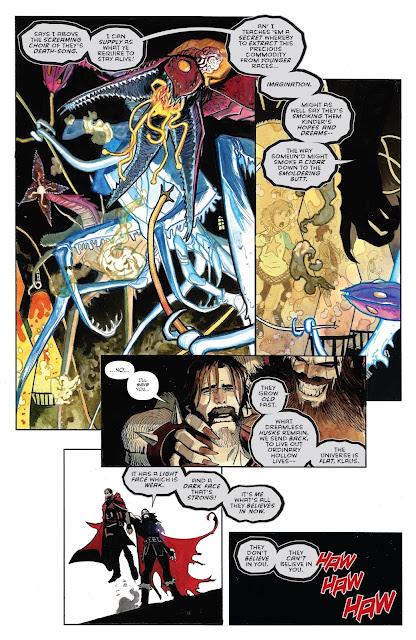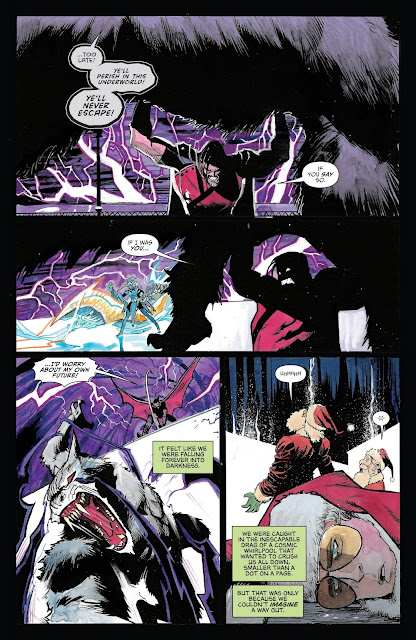At the end of my review of John Russell Fearn's GOLDEN AMAZON, I said:
From this one adventure it's impossible to judge whether or not Fearn has much to say about Marston's favorite subject, female empowerment. But I have the next two books in the series and will make some effort to find out.
Based on my reading of the next two novels in the refurbished series-- which seem to be the only ones readily available through major commercial venues-- I would say that Fearn drops most of the tropes involved with female empowerment. In addition, because his new series had met with favor from readers, he ceases to emphasize what I called "the tycoon narrative" seen in the first book, and seems to be working his way back to the original template, in that the titular Amazon Violet Ray began as a space-opera crusader in the veins of both John Carter and Buck Rogers. I can only guess as to whether she becomes a full-time crusader in the later novels, though.
In my review I noted that the Golden Amazon's first character arc is that of a villain, and I wondered if Fearn had killed her off just in case this new template proved unpopular. But now it's quite evident that the author had at the very least sketched out a plausible way for Violet to return from the halls of the dead, arguably stronger than in her "first life." The first novel established that despite her "masculine" strength and intellectual drive, Violet is fated to burn herself out, and this information is communicated to the protagonist about halfway through the first book.
The next two novels, while capable of being independently read, could be viewed as one long novel in two parts, given that they concern a new villain to take the place occupied by the Amazon in the first book. In RETURNS, Violet's adoptive sister Beatrice and her husband Chris have been married about five years and have a little girl. Former Third Reich scientist Carl Mueller organizes a gang of malcontents in order to mount missile attacks on Earth from the moon with the purpose of forcing all governments to capitulate to Mueller. It's at this point that Violet Ray comes back from the dead in dramatic fashion, using her super-strength to beat up four tough male agents of Mueller's. Violet explains to her former foes that she anticipated Beatrice's scheme against her in the first book and used that old standby, an android duplicate, to fake Violet's death so that she could escape and retrench, building a super-scientific enclave in a remote mountain-area. In addition, she used her super-genius to correct her metabolism problems, so that she could experience a normal life-span.
Fearn hand-waves Violet's list of past crimes by claiming that since the law declared her dead, she can't be prosecuted for anything. I don't think that would have worked if the law could have demonstrated how she had pulled off her fake death. Further, the author missed a bet by not stressing the way her correction of her faulty metabolism could have altered her outlook. In RETURNS the Amazon has lost her frenetic desire for control, and Fearn could have argued that her mind was affected by her faulty metabolism, which when corrected made it possible for her to take a more heroic attitude. In addition, she seems much stronger than before, now being able to snap a metal chain in two. The Amazon of the original book couldn't even defeat a single man who possessed a little judo skill.
I won't dwell on the specific events of either RETURNS or TRIUMPH, because they both involve Violet and her entourage journeying to other planets in Earth's solar system. Both times, they seek to counter Mueller's evil schemes, both involving missile attacks on Earth. The moon adventure is OK, but the "swampy Venus" locale of TRIUMPH is a lot more fun, and allows for much more colorful pulp pseudo-science. Mueller is defeated in RETURNS but escapes to launch much the same kind of menace in TRIUMPH, only to be decisively conquered and slain. Mueller's only symbolic significance is that of being an "antitype" to the Amazon, essentially incarnating the evil she's renounced. Strangely, neither Mueller nor any of his allies from WWII Germany ever seem like ideological Nazis. Perhaps Fearn, who was moving the series in the direction of space opera (albeit set in the "far future" of the 1960s) thought that references to Hitler and the Final Solution would have worked against the futuristic milieu he was promoting. By the end of TRIUMPH, it's evident that the space-faring technology created by the Golden Amazon will make it possible for Earthpeople to extend their range into other galaxies. Thus, even though Fearn reworked the 1939 version of his heroine to be less of a standard space-opera champion by placing her origins on Earth, it appears that once the character proved popular he slowly began moving his Amazonian avenger back in the direction of The Final Frontier.
I believe I've read that eventually Fearn allows Violet to conquer her antipathy to romance, so that she marries and raises a family. There are no hints of such a sea-change here, though Fearn devotes a subplot to a love-tale between two support-characters. But going on the first three books, the Golden Amazon stories seem most significant for focusing on a heroine with a penchant for pure superheroic action.







































